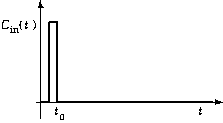
Therefore, we use an impulse input function in modeling lakes to represent a sudden introduction of contaminant into the lake. The spike represents the time at which the contaminant was dumped. At all other times before and after the dumping, no contaminant is entering the lake.
Usually, when we use an impulse input function we are working on a problem in which some contaminant has been spilled and we now wish to find out what level of contaminant remains after some time has passed. An example is contained in the fisherman problem discussed elsewhere in the module.
In our simulations, we suppose that the spill or dumping took place just before the simulation began. We then enter the initial concentration of the contaminant of the lake, and begin the simulation.
Of course, the impulse input function is just convenient way of thinking about such models. The pollution might have entered the lake over any amount of time and in any quantity. The significant points are that
To return to the page you came from, press the Back button on your browser.